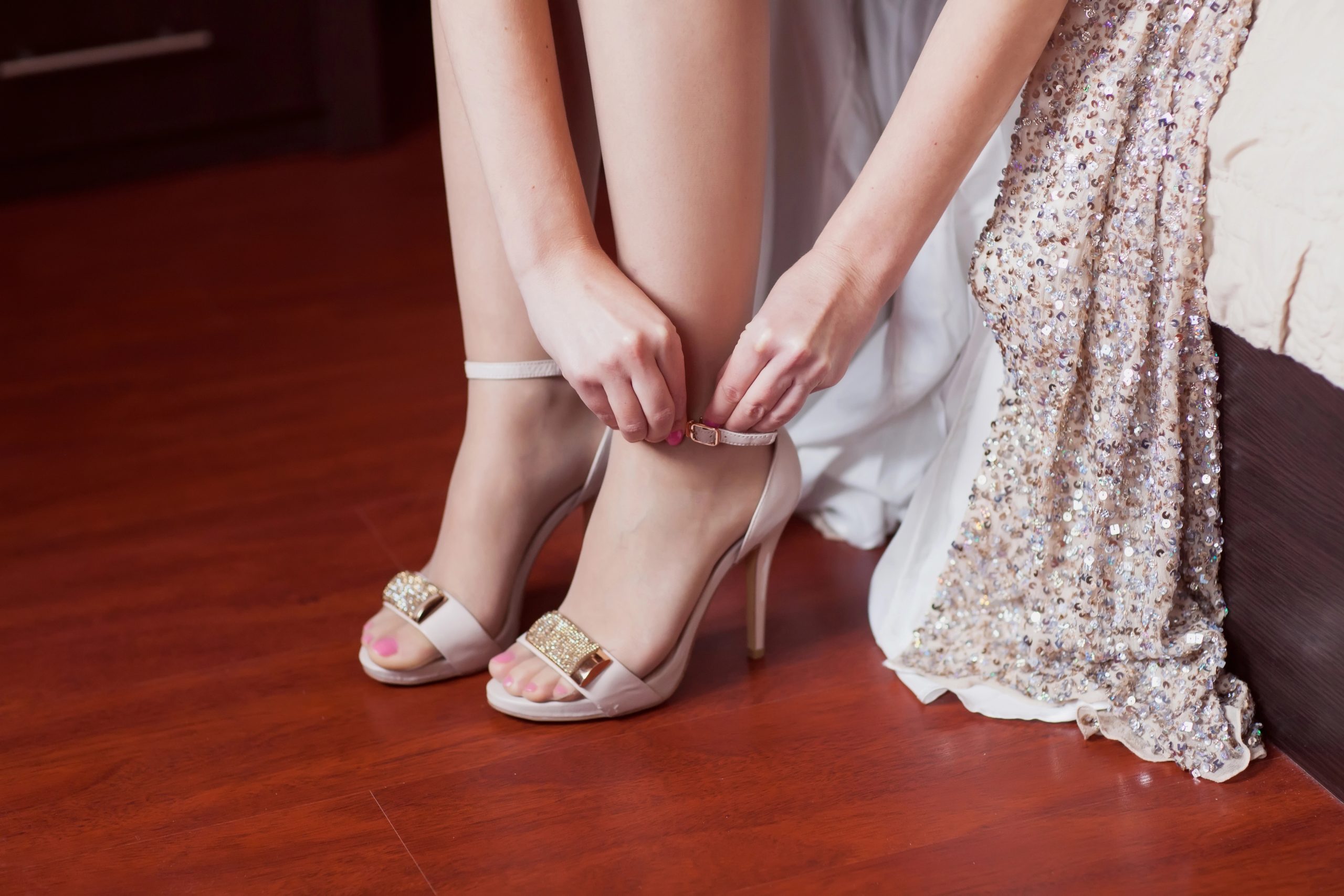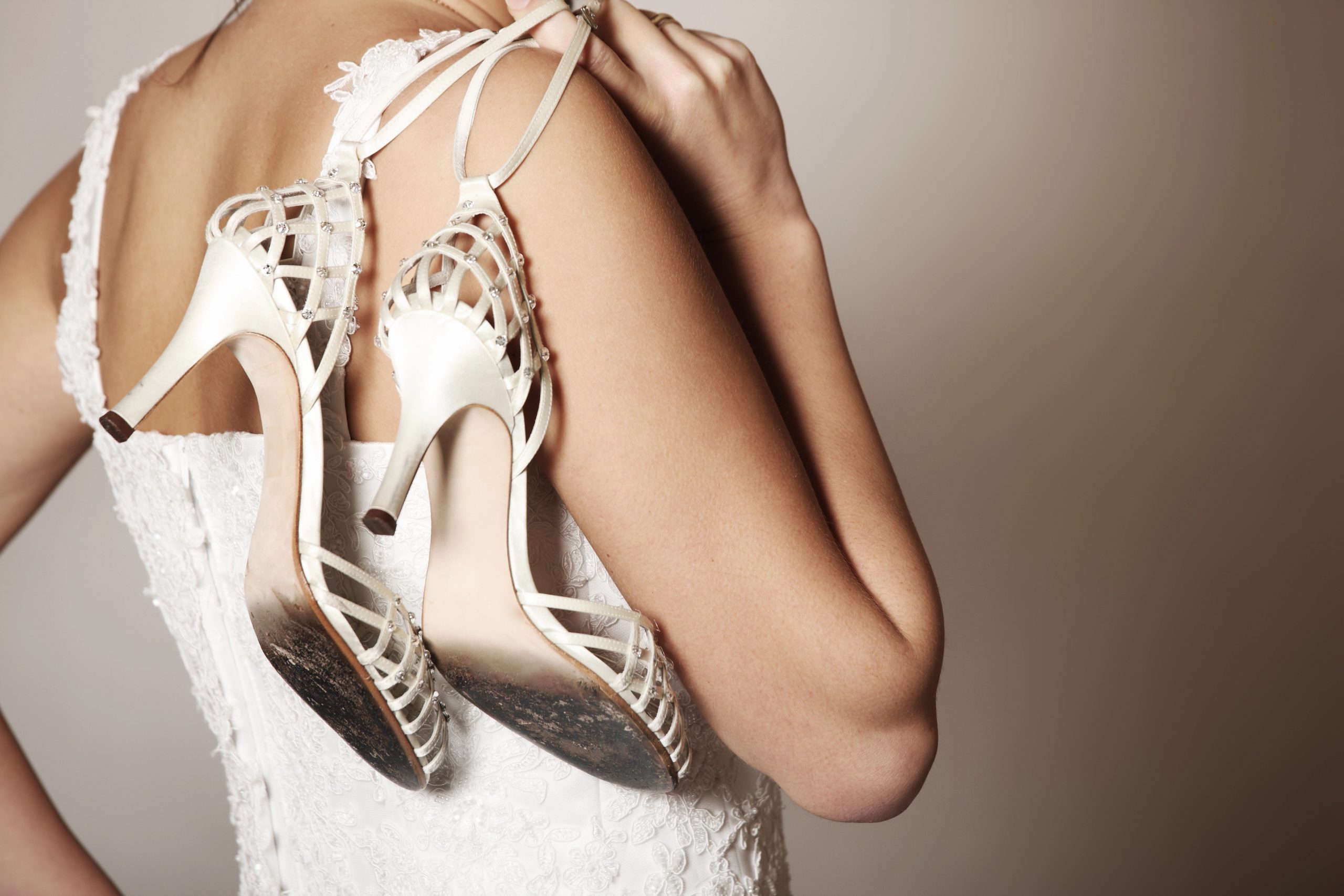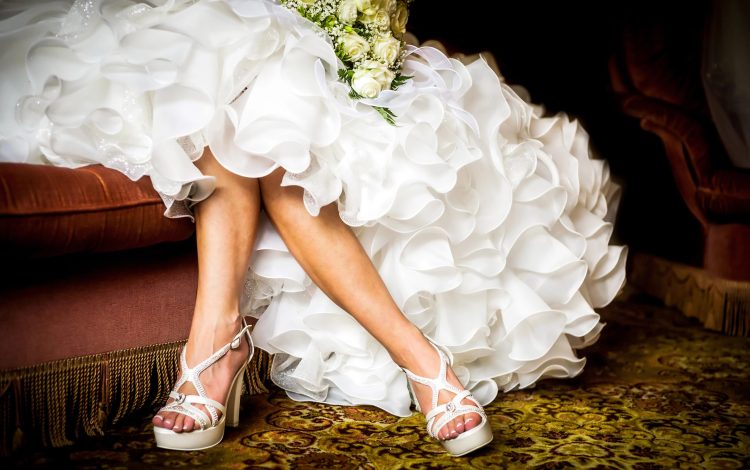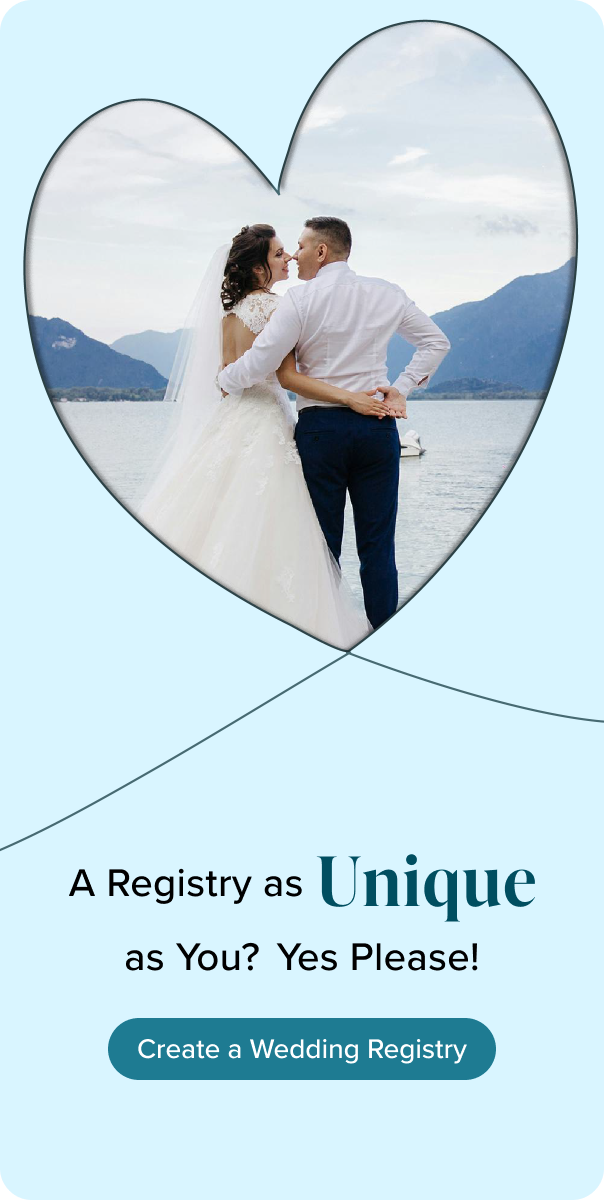Choosing the perfect bridal shoes is one of the most important decisions you’ll make for your wedding day, yet it’s often overlooked until the last minute.
Your wedding shoes need to complement your dress, support you through hours of standing and dancing, and make you feel confident and beautiful as you walk down the aisle.
The right bridal shoes do more than complete your look. They affect your comfort, posture, and confidence throughout your entire wedding day. From the ceremony to the reception and everything in between, your shoes will carry you through one of the most important days of your life.
This comprehensive guide covers everything you need to know about selecting, fitting, and preparing your bridal shoes for the perfect wedding day experience. Whether you’re dreaming of sky-high heels or comfortable flats, we’ll help you make the best choice for your style, venue, and comfort needs.
Planning your dream wedding and want to keep track of all your bridal essentials?
Create a wedding registry to organize everything you need for your perfect day, from shoes to accessories and beyond.
Why Bridal Shoes Matter More Than You Think
Your choice of wedding shoes affects multiple aspects of your wedding day experience, making this decision more crucial than many brides initially realize.
Comfort Throughout the Day
Wedding days are long, often lasting 12-16 hours from the time of getting ready to the end of the reception. Your feet will carry you through the ceremony standing, photo sessions, receiving line greetings, and hours of dancing. Uncomfortable shoes can turn your dream day into a painful endurance test.
Posture and Confidence
The right shoes can significantly impact how you stand, walk, and carry yourself. A proper fit and appropriate heel height help you maintain good posture, allowing you to feel confident and graceful in your movements.
Dress Fit and Hemline
Your shoe choice directly impacts your dress hem length and overall silhouette. Changes in heel height after dress alterations can result in costly hemline adjustments or an imperfect dress fit.
Photography Considerations
Your shoes will appear in many wedding photos, from detail shots to full-length portraits. They should complement your overall bridal aesthetic while photographing beautifully from every angle.
According to bridal fashion experts, comfortable, well-fitted wedding shoes significantly impact a bride’s overall wedding day experience and confidence levels.
Understanding Different Bridal Shoe Styles
Wedding shoes come in numerous styles, each offering different benefits and aesthetic appeals for various wedding themes and personal preferences.
Classic Pumps and Closed-Toe Options
Traditional pumps provide timeless elegance and work well with most dress styles. They offer more foot coverage and support than open-toe options while creating clean, classic lines that photograph beautifully.
Pointed-toe pumps elongate the leg and create sophisticated silhouettes, while rounded toes offer more comfort for longer wear. Block heels provide stability, while stilettos create dramatic height and elegance.
Strappy Sandals and Open-Toe Designs
Strappy sandals add romantic, delicate details that complement flowing dress styles and outdoor weddings. They provide opportunities for decorative elements like crystals, pearls, or metallic accents.
Ankle straps offer additional security and support, while T-bar styles create vintage-inspired looks that work well with retro or garden party themes.
Flats and Low-Heel Options
Ballet flats, embellished flats, or low-heeled options prioritize comfort while still maintaining bridal elegance. These choices work particularly well for outdoor weddings, beach ceremonies, or brides who prioritize comfort over height.
Pointed-toe flats create sophisticated looks, while rounded options offer maximum comfort. Embellished flats with pearls, crystals, or lace details maintain bridal glamour without sacrificing wearability.
Specialty and Theme-Specific Styles
Cowboy boots for rustic weddings, vintage-inspired shoes for retro themes, or colorful options for non-traditional celebrations allow brides to express their personality while maintaining appropriate formality.
Alternative Options
Wedges provide height with better stability, while ankle boots offer edgy sophistication for modern brides. Sneakers, while unconventional, provide ultimate comfort for casual or outdoor celebrations.

Heel Height Considerations
Choosing the right heel height involves balancing style preferences with comfort needs and practical considerations for your specific wedding day activities.
Low Heels (1-2 inches)
Low heels offer excellent comfort for long wear while providing subtle height and leg lengthening. They’re ideal for outdoor weddings, beach ceremonies, or brides who aren’t comfortable in higher heels.
These heights work well for garden parties, casual celebrations, or any situation where you’ll be walking on grass, sand, or uneven surfaces.
Medium Heels (2-3 inches)
Medium heels provide a good balance between height and comfort, offering leg lengthening benefits while remaining manageable for extended wear. They work well for most wedding venues and dress styles.
This height range accommodates most comfort levels while still creating elegant silhouettes and sophisticated looks that photograph beautifully.
High Heels (3-4 inches)
High heels create dramatic height and elegant proportions while requiring more consideration for comfort and stability. They work well for formal indoor venues and sophisticated evening celebrations.
Consider your comfort level with high heels and the amount of standing and walking required during your wedding day when choosing this height range.
Very High Heels (4+ inches)
Very high heels create stunning proportions and dramatic elegance but require significant comfort considerations and possibly backup shoe options for dancing and extended wear.
Only choose this height if you’re very comfortable wearing high heels for extended periods and have experience dancing and walking in similar heights.
According to podiatrists, the optimal heel height for extended wear is typically 2-3 inches, as this provides height benefits while minimizing foot strain and discomfort.
Material and Construction Considerations
The materials and construction quality of your bridal shoes significantly impact both comfort and durability throughout your wedding day.
Leather Options
Genuine leather provides excellent breathability, durability, and tends to stretch and conform to foot shape over time. Full-grain leather offers the highest quality and longest-lasting wear.
Patent leather creates formal, glossy finishes that photograph beautifully while providing easy care and maintenance. However, it offers less breathability than regular leather options.
Satin and Fabric Choices
Satin creates classic bridal elegance and can be dyed to match dress colors perfectly. However, satin shows scuffs and stains easily and offers less durability than leather options.
Silk, lace, or other fabric coverings provide unique textures and romantic details while requiring more careful handling and maintenance throughout the wedding day.
Synthetic Materials
High-quality synthetic materials can provide good comfort and appearance while offering lower costs than genuine leather. However, they typically offer less breathability and may not conform to foot shape as well.
Sole Construction
Leather soles provide traditional elegance but can be slippery on smooth surfaces. Rubber soles offer better traction and comfort but may appear less formal in detailed photographs.
Cushioned insoles, arch support, and quality construction methods significantly impact all-day comfort and should be priority considerations regardless of exterior materials.
Sizing and Fit Essentials
Proper sizing and fit are crucial for bridal shoe success, as ill-fitting shoes can ruin your wedding day experience regardless of how beautiful they look.
Professional Measurement
Have your feet professionally measured at a shoe store, as foot size can change over time due to weight fluctuations, pregnancy, or natural aging. Measure both feet, as they’re often slightly different sizes.
Measure feet in the late afternoon or evening when they’re naturally slightly swollen, similar to how they’ll feel during your long wedding day.
Size Variations Between Brands
Shoe sizes vary significantly between manufacturers and styles. Always try on shoes rather than assuming your usual size will fit, and be prepared to order different sizes if shopping online.
European, UK, and US sizing systems differ considerably, so pay careful attention to sizing charts when ordering international brands.
Width Considerations
Consider foot width as well as length, as narrow or wide feet may require specific size adjustments or brands that cater to different width needs.
Break-In Time Requirements
Plan for adequate break-in time, as new shoes often require wearing to become comfortable. Begin this process at least 2-3 weeks before your wedding to allow for adjustments or exchanges if needed.
Fit Testing Throughout the Day
Test shoes at different times of day to ensure they remain comfortable as your feet naturally swell throughout extended wear periods.

Color and Style Coordination
Your bridal shoes should complement your dress and overall wedding aesthetic while reflecting your personal style and theme preferences.
Traditional White and Ivory
Classic white and ivory shoes create timeless elegance and work well with most dress colors and styles. Ensure the white or ivory tone matches or complements your dress shade rather than clashing.
True white tends to be brighter and more stark, while ivory offers warmer, more romantic tones that often complement dress fabrics better.
Metallic Options
Gold, silver, and rose gold shoes add glamorous touches while remaining neutral enough to work with most dress styles. Metallics photograph beautifully and add subtle sparkle to your overall look.
Consider your jewelry and accessory metals when choosing metallic shoe colors to ensure cohesive styling throughout your bridal ensemble.
Bold Color Choices
Colored shoes allow for personal expression and can incorporate wedding theme colors or meaningful hues. Popular choices include blush pink, navy blue, or jewel tones that complement your color palette.
Consider how colored shoes will appear in photographs and whether you want them to be subtle accents or bold statement pieces in your bridal look.
Pattern and Texture Considerations
Lace, beading, crystals, or other decorative elements should complement rather than compete with dress details. Consider the overall balance of embellishment throughout your entire bridal ensemble.
According to bridal styling experts, shoes should either complement the dress’s level of embellishment or provide subtle contrast to create visual balance in the overall bridal look.
Venue and Season Considerations
Your wedding venue and season significantly impact appropriate shoe choices, affecting both style and practical considerations for your special day.
Indoor Venue Considerations
Indoor venues typically allow for more delicate shoe options and higher heels, as you’ll be walking on smooth, even surfaces. Consider the formality level of your venue when choosing shoe styles.
Ballrooms and formal venues accommodate elegant heels and delicate materials, while casual indoor spaces might call for more relaxed shoe choices.
Outdoor Wedding Challenges
Outdoor venues require careful consideration of heel types, sole materials, and overall shoe stability. Grass, sand, gravel, or uneven surfaces can make high heels impractical or dangerous.
Consider wedges, block heels, or flats for outdoor ceremonies, and always have backup options available for different parts of your celebration.
Seasonal Weather Factors
Summer weddings may require breathable materials and consideration for foot swelling in heat, while winter celebrations might need weather-appropriate materials and coverage.
Spring and fall weddings should account for potential weather changes and varying ground conditions that might affect shoe choices throughout the day.
Beach and Destination Weddings
Beach weddings typically require special consideration for sand, potential water exposure, and the impracticality of traditional heels. Consider sandals, flats, or going barefoot for ceremony portions.
Destination weddings may limit your ability to try on shoes in advance, making online ordering and careful size research more important.
Shopping Timeline and Strategy
Successful bridal shoe shopping requires strategic timing and planning to ensure you have the perfect shoes ready for your wedding day.
When to Start Shopping
Begin shoe shopping 3-4 months before your wedding to allow time for ordering, delivery, returns, exchanges, and adequate break-in time.
If you’re having your dress altered, finalize shoe choices before final dress fittings to ensure proper hem length and overall proportions.
Trying On and Testing Process
When trying on bridal shoes, wear similar hosiery to what you’ll wear on your wedding day, and test shoes on various surfaces similar to your venue flooring.
Walk around the store, stand for extended periods, and consider how the shoes feel after 15-20 minutes of wear to simulate wedding day conditions.
Online Shopping Considerations
When shopping online, research return policies carefully and order multiple sizes or styles if uncertain. Read reviews from other brides about sizing and comfort.
Order shoes well in advance to allow time for returns and exchanges, and consider the additional time needed for any customizations or special orders.
Backup Plan Development
Always have a backup shoe option available, whether it’s a more comfortable pair for dancing or a completely different style in case your primary choice becomes uncomfortable.
Consider purchasing gel inserts, heel grips, or other comfort accessories to enhance your chosen shoes if needed.
Comfort Enhancements and Accessories
Various accessories and modifications can significantly improve the comfort and wearability of your bridal shoes throughout your wedding day.
Insoles and Cushioning
Gel insoles, metatarsal pads, or cushioned inserts can dramatically improve comfort, especially for shoes with minimal built-in padding or arch support.
Ball-of-foot cushions, heel grips, and arch supports address specific pressure points and can make less-than-perfect fits more comfortable for extended wear.
Blister and Friction Prevention
Moleskin patches, blister prevention tape, or friction-reducing products can prevent painful hot spots and blisters during long wedding days.
Break in new shoes gradually while using these preventive measures to identify and address potential problem areas before your wedding day.
Emergency Kit Preparation
Prepare a wedding day shoe emergency kit including bandages, pain relievers, backup insoles, and comfortable flip-flops or slippers for emergency foot relief.
Care and Maintenance
Proper care of your bridal shoes ensures they look perfect on your wedding day and can potentially be preserved as keepsakes afterward.
Pre-Wedding Preparation
Clean and condition shoes appropriately for their materials, and consider professional waterproofing for outdoor weddings or unpredictable weather conditions.
Practice walking in your shoes on various surfaces and in your wedding dress to identify any potential issues before your wedding day.
Wedding Day Care
Bring shoe cleaning supplies for touch-ups throughout the day, and have someone designated to help with shoe changes if you’re switching between ceremony and reception shoes.
Post-Wedding Preservation
Clean shoes thoroughly after your wedding day and consider professional preservation services if you want to keep them as keepsakes or pass them down to family members.
Document your shoes with photographs as part of your wedding day details, as these images often become treasured memories of your special day preparation.
Creating Your Perfect Bridal Shoe Experience
The key to bridal shoe success lies in balancing style preferences with practical considerations while allowing adequate time for selection, fitting, and preparation.
Consider your priorities: comfort, style, height, or specific aesthetic goals, and make decisions that align with your overall wedding vision and personal comfort needs.
Remember that confidence comes from feeling comfortable and secure in your choices, so prioritize fit and comfort alongside aesthetic preferences.
Think about your wedding day timeline, activities, and venue requirements when making final decisions, and always have contingency plans for comfort and weather considerations.
Your bridal shoes are an investment in your wedding day experience and confidence. Take the time to choose thoughtfully, prepare adequately, and enjoy the process of finding the perfect pair that will carry you through your special day.
Ready to start planning every detail of your perfect wedding day?
Create your wedding registry today and begin building your dream celebration with all the essentials that will make your day unforgettable, from the perfect shoes to every other special detail.
Looking for more bridal planning inspiration and guidance? Explore our wedding registry inspiration boards for comprehensive planning resources and ideas.


